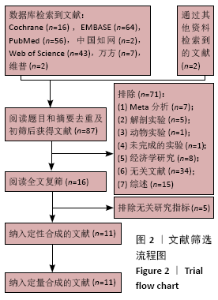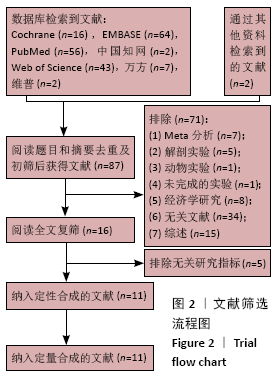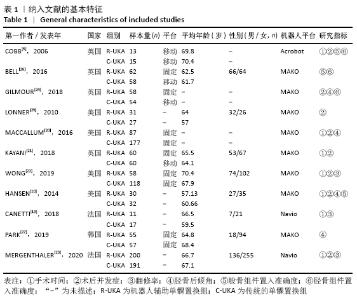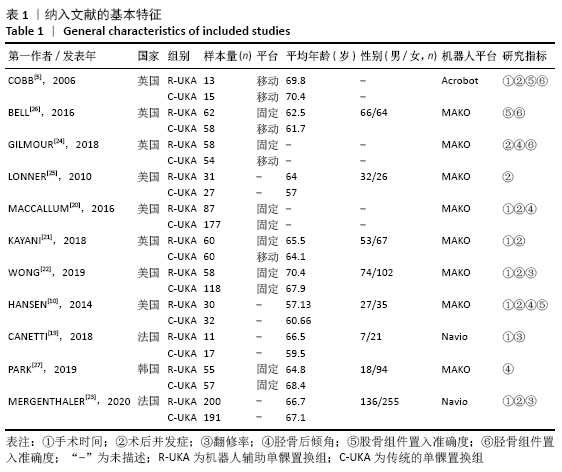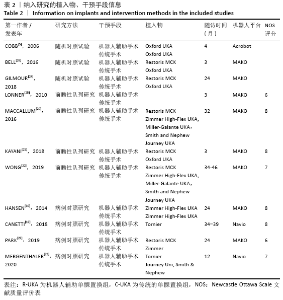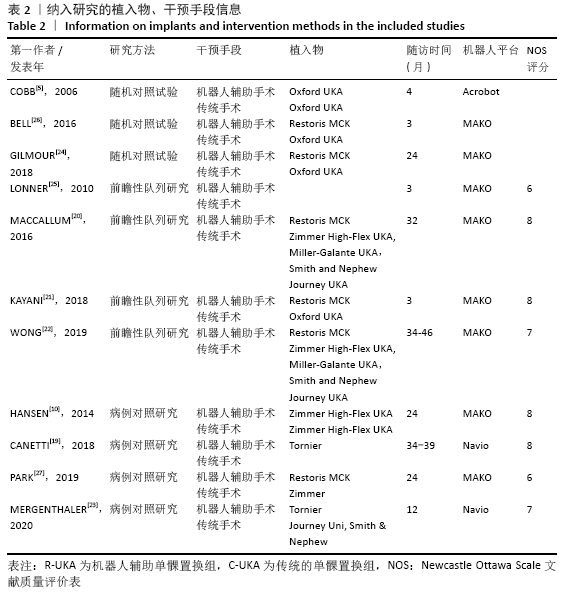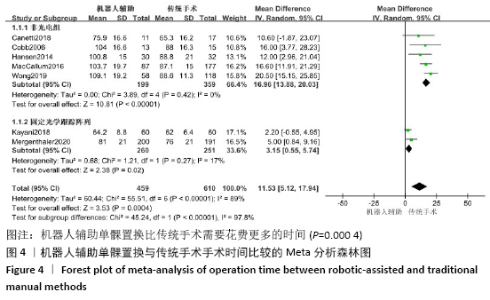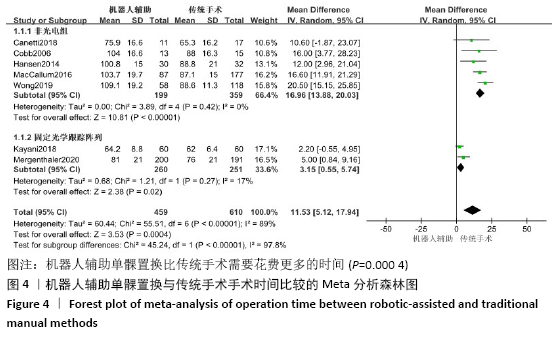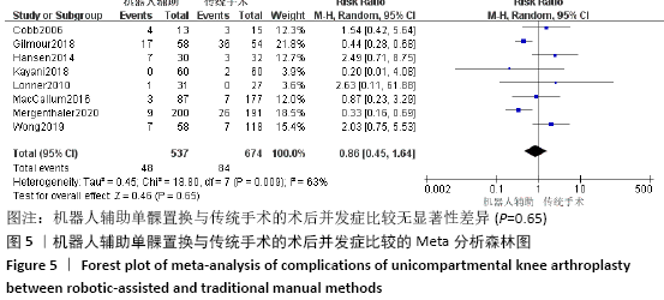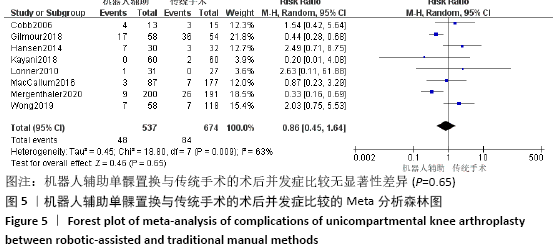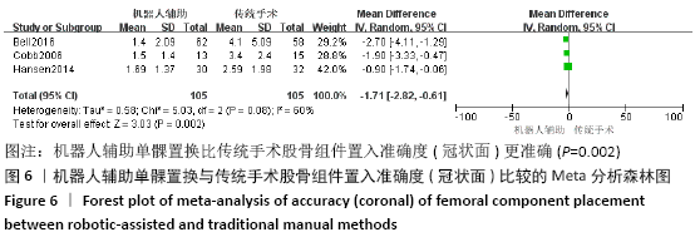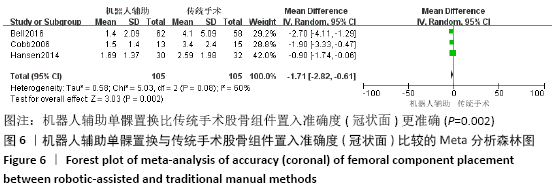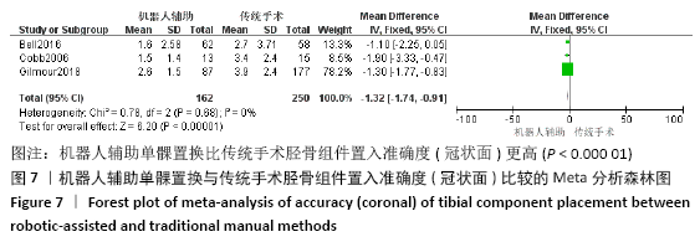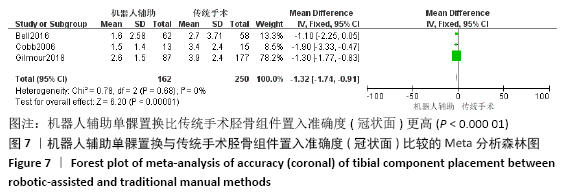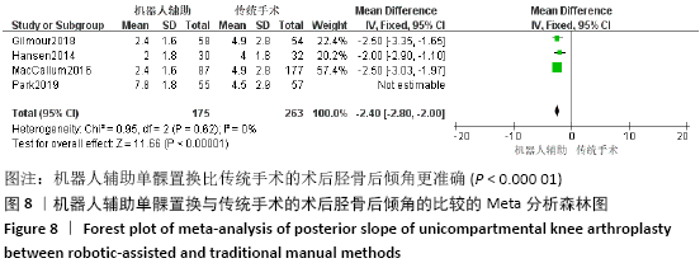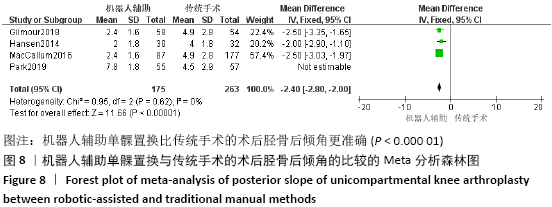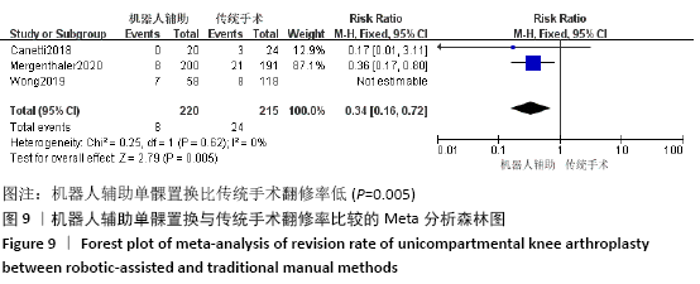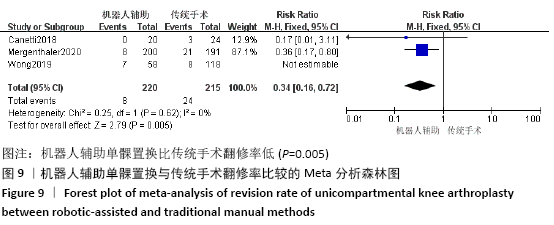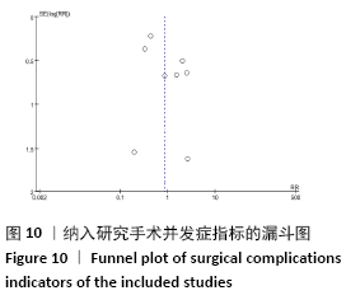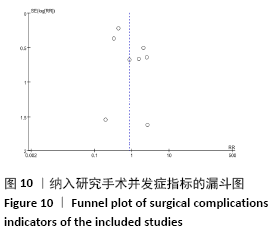Chinese Journal of Tissue Engineering Research ›› 2021, Vol. 25 ›› Issue (21): 3416-3422.doi: 10.3969/j.issn.2095-4344.3874
Previous Articles Next Articles
Meta-analysis of the postoperative effects of robot-assisted unicompartmental knee arthroplasty versus conventional surgery
Ren Xingyu1, Zhang Yi1, Xu Haoran1, Fan Bin1, Dai Shifeng2, Liang Chunyu1
- 1North China University of Science and Technology Affiliated Hospital, Tangshan 063000, Hebei Province, China; 2Second Hospital of Tangshan, Tangshan 063000, Hebei Province, China
-
Received:2020-09-02Revised:2020-09-04Accepted:2020-10-24Online:2021-07-28Published:2021-01-25 -
Contact:Liang Chunyu, Master, Chief physician, North China University of Science and Technology Affiliated Hospital, Tangshan 063000, Hebei Province, China -
About author:Ren Xingyu, Master candidate, Physician, North China University of Science and Technology Affiliated Hospital, Tangshan 063000, Hebei Province, China
CLC Number:
Cite this article
Ren Xingyu, Zhang Yi, Xu Haoran, Fan Bin, Dai Shifeng, Liang Chunyu. Meta-analysis of the postoperative effects of robot-assisted unicompartmental knee arthroplasty versus conventional surgery[J]. Chinese Journal of Tissue Engineering Research, 2021, 25(21): 3416-3422.
share this article

2.2 文献质量评估结果 文章共纳入11篇文献[5,10,19-27];由2名医师对纳入文献进行独立分析。分别对照Cochrane偏倚风险评估标准的6个项目,若文献在每个项目上均为低风险偏倚,则将该文献视为低度偏倚文献;若在1或2个项目上为高风险偏倚或不确定,则将该文献视为中度偏倚文献;若2个以上项目为高风险偏倚或不确定,则将该文献视为高度偏倚文献。如遇分歧则讨论解决或交由第3位高年资医师共同裁定文献质量。有3篇随机对照试 验[5,24,26],其中低风险偏倚1篇[5],中风险偏倚1篇[24],高风险偏倚1篇[26],见图3。队列研究4篇[20-22,25],病例对照研究4篇[10,19,23,27],经NOS评分标准达6分以上则属于高质量,有4篇达到8分[10,19-21],有2篇达到7分[22-23],有2篇达到6分[25,27],文献质量均较高。"

| [1] ZHANG F, LI H, BA Z, et al. Robotic arm-assisted vs conventional unicompartmental knee arthroplasty: a meta-analysis of the effects on clinical outcomes. Medicine. 2019;98(35):e16968. [2] FU J, WANG Y, LI X, et al. Robot-assisted vs. conventional unicompartmental knee arthroplasty: systematic review and meta-analysis. Orthopade. 2018;47(12): 1009-1017. [3] VANDERLIST JP, CHAWLA H, PEARLE AD. Robotic-assisted knee arthroplasty: an overview. Am J Orthop. 2016;45(4): 202-211. [4] 高阳阳,车先达,韩鹏飞,等.机器人辅助与传统手法行单髁置换效果的Meta分析[J].中国组织工程研究,2019,23(36): 5889-5895. [5] COBB J, HENCKEL J, GOMES P, et al. Hands-on robotic unicompartmental knee replacement. A prospective, randomised controlled study of the Acrobot system. J Bone oint Surg (Series B). 2006;88(2):188-197. [6] 蔡尚欢,宋永伟,曹向阳,等.骨科机器人应用现状与研究进展[J].山东医药, 2018,58(44):90-93. [7] 赵燕鹏,唐佩福.骨科机器人及导航技术研究进展[J].中国矫形外科杂志,2016, 24(3):242-246. [8] 韩晓光,刘亚军,范明星,等.骨科手术机器人技术发展及临床应用[J].科技导报,2017,35(10):19-25.[9] RODRIGUEZ F, HARRIS S, JAKOPEC M, et al. Robotic clinical trials of uni-condylar arthroplasty. Int J Med Robot. 2005;1(4): 20-28. [10] HANSEN DC, KUSUMA SK, PALMER RM, et al. Robotic guidance does not improve component position or short-term outcome in medial unicompartmental knee arthroplasty. J Arthroplasty. 2014;29(9):1784-1789. [11] GAUDIANI MA, SAMUEL LT, KAMATH AF, et al. Robotic-assisted versus manual unicompartmental knee arthroplasty: contemporary systematic review and meta-analysis of early functional outcomes. J Knee Surg. 2020. doi: 10.1055/s-0040-1701455. [12] BATAILLER C, WHITE N, RANALDI FM, et al. Improved implant position and lower revision rate with robotic-assisted unicompartmental knee arthroplasty. Knee Surg Sports Traumatol Arthrosc. 2019;27(4):1232-1240. [13] CHIN BZ, TAN SS, CHUA KC, et al. Robot-assisted versus conventional total and unicompartmental knee arthroplasty: a meta-analysis of radiological and functional outcomes. J Knee Surg. 2020. doi: 10.1055/s-0040-1701440. [14] VANDERLIST JP, CHAWLA H, JOSKOWICZ L, et al. Current state of computer navigation and robotics in unicompartmental and total knee arthroplasty: a systematic review with meta-analysis. Knee Surg Sports Traumatol Arthrosc. 2016;24(11):3482-3495. [15] KARUNARATNE S, DUAN M, PAPPAS E, et al. The effectiveness of robotic hip and knee arthroplasty on patient-reported outcomes: a systematic review and meta-analysis. Int Orthop. 2019;43(6):1283-1295. [16] 中华医学会骨科学分会关节外科学组.骨关节炎诊疗指南(2018年版)[J].中华骨科杂志,2018,38(12):705-715. [17] 戴雪松,宓云峰,熊炎,等.活动与固定平台的单髁假体置换治疗膝关节内侧间室骨关节炎[J]. 中华骨科杂志,2015, 35(7):691-698. [18] ANDREAS S. Critical evaluation of the Newcastle-Ottawa scale for the assessment of the quality of nonrandomized studies in meta-analyses. Eur J Epidemiol. 2010; 25(9):603-605. [19] CANETTI R, BATAILLER C, BANKHEAD C, et al. Faster return to sport after robotic-assisted lateral unicompartmental knee arthroplasty: a comparative study. Arch Orthop Trauma Surg. 2018;138(12):1765-1771. [20] MACCALLUM KP, DANOFF JR, GELLER JA. Tibial baseplate positioning in robotic-assisted and conventional unicompartmental knee arthroplasty. Eur J Orthop Surg Traumatol. 2016;26(1):93-98. [21] KAYANI B, KONAN S, PIETRZAK JR, et al. The learning curve associated with robotic-arm assisted unicompartmental knee arthroplasty: a prospective cohort study. Bone Joint J. 2018;100(8):1033-1042. [22] WONG J, MURTAUGH T, LAKRA A, et al. Robotic-assisted unicompartmental knee replacement offers no early advantage over conventional unicompartmental knee replacement. Knee Surg Sports Traumatol Arthrosc. 2019;27(7):2303-2308. [23] MERGENTHALER G, BATAILLER C, LORDING T, et al. Is robotic-assisted unicompartmental knee arthroplasty a safe procedure? A case control study. Knee Surg Sports Traumatol Arthrosc. 2020. doi: 10.1007/s00167-020-06051-z. [24] GILMOUR A, MACLEAN AD, ROWE PJ, et al. Robotic-arm–assisted vs conventional unicompartmental knee arthroplasty. the 2-year clinical outcomes of a randomized controlled trial. J Arthroplasty. 2018;33(7): 109-115. [25] LONNER JH, JOHN TK, CONDITT MA. Robotic arm-assisted uka improves tibial component alignment: a pilot study. Clin Orthop Relat Res. 2010;468(1):141-146. [26] BELL SW, ANTHONY I, JONES B, et al. Improved accuracy of component positioning with robotic-assisted unicompartmental knee arthroplasty: data from a prospective, randomized controlled study. J Bone Joint Surg Am. 2016;98(8):627-635. [27] PARK KK, HAN CD, YANG IH, et al. Robot-assisted unicompartmental knee arthroplasty can reduce radiologic outliers compared to conventional techniques. PLoS One. 2019;14(12):e0225941. [28] JULIE RS, PHILIP ER, PHILIP JR. Accuracy of a freehand sculpting tool for unicondylar knee replacement. Int J Med Robot. 2014; 10(2):162-169. [29] ALI M, JOHANNES FP, BO L, et al. Assessment of accuracy of robotically assisted unicompartmental arthroplasty. Knee Surg Sports Traumatol Arthrosc. 2014; 22(8):1918-1925. [30] CITAK M, SUERO EM, CITAK M, et al. Unicompartmental knee arthroplasty: is robotic technology more accurate than conventional technique? Knee. 2013;20(4): 268-271. [31] MATSEN FA, GARBINI JL, SIDLES JA, et al. Robotic assistance in orthopaedic surgery. A proof of principle using distal femoral arthroplasty. Clin Orthop Relat Res. 1993; (296):178-186. [32] IÑIGUEZ M, NEGRÍN R, DUBOY J, et al. Robot-assisted unicompartmental knee arthroplasty: increasing surgical accuracy? A Cadaveric Study. J Knee Surg. 2019. doi: 10.1055/s-0039-1698771. [33] BARBADORO P, ENSINI A, LEARDINI A, et al. Tibial component alignment and risk of loosening in unicompartmental knee arthroplasty: a radiographic and radiostereometric study. Knee Surg Sports Traumatol Arthrosc. 2014;22(12):3157-3162. [34] JEANYVES J, CYRIL B. Unicompartmental knee prosthesis implantation with a non-image-based navigation system: rationale, technique, case-control comparative study with a conventional instrumented implantation. Knee Surg Sports Traumatol Arthrosc. 2003;11(1):40-45. [35] QIAN LM, JOSEPH DL, CHENG KC, et al. A Comparison between chinese and caucasian 3-dimensional bony morphometry in presimulated and postsimulated osteotomy for total knee arthroplasty. J Arthroplasty. 2017;32(9):2878-2886. [36] MICHAEL EN, ANTHONY A, NELSON VG, et al. A comparison of mobile and fixed-bearing unicompartmental knee arthroplasty at a minimum 10-year follow-up. J Arthroplasty. 2018;33(6):1713-1718. [37] MILLAR LJ, BANGER M, ROWE PJ, et al. O 017-A five-year follow up of gait in robotic assisted vs conventional unicompartmental knee arthroplasty. Gait Posture. 2018;65(1): 31-32. [38] MOTESHAREI A, ROWE P, BLYTH M, et al. A comparison of gait one year post operation in an RCT of robotic UKA versus traditional Oxford UKA. Gait Posture. 2018;62:41-45. [39] BLYTH MJ, ANTHONY I, ROWE P, et al. Robotic arm-assisted versus conventional unicompartmental knee arthroplasty: Exploratory secondary analysis of a randomised controlled trial. Bone Joint Res. 2017;6(11):631-639. [40] RAJ KS. Outcomes of robotic arm-assisted unicompartmental knee arthroplasty. Am J Orthop. 2009;38(2 Suppl):20-22. [41] JINNAH AH, AUGART MA, LARA DL, et al. Decreased time to return to work using robotic-assisted unicompartmental knee arthroplasty compared to conventional techniques. Surg Technol Int. 2018;32: 279-283. [42] MOSCHETTI WE, KONOPKA JF, RUBASH HE, et al. Can robot-assisted unicompartmental knee arthroplasty be cost-effective? A Markov Decision Analysis. J Arthroplasty. 2016;31(4):759-765. [43] NHERERA L, VERMA S, TRUEMAN P. MT1 cost-effectiveness of robotic-assisted unicompartmental knee arthroplasty (R-UKA)* compared to traditional unicompartmental knee arthroplasty (T-UKA). Value Health. 2019;22(2):S41. [44] CLEMENT ND, DEEHAN DJ, PATTON JT. Corrigenda: Robot-assisted unicompartmental knee arthroplasty for patients with isolated medial compartment osteoarthritis is cost-effective: a Markov decision analysis. Bone Joint J. 2019;101(9): 1063-1070. [45] YEROUSHALMI D, FENG J, NHERERA L, et al. Early economic analysis of robotic-assisted unicondylar knee arthroplasty may be cost effective in patients with end-stage osteoarthritis. J Knee Surg. 2020. doi: 10.1055/s-0040-1712088. [46] LONNER JH, FILLINGHAM YA. Pros and cons: a balanced view of robotics in knee arthroplasty. J Arthroplasty. 2018;33(7): 2007-2013. [47] 曹旭含,白子兴,孙承颐,等.机器人在骨科手术中应用的可靠性与提升空间[J].中国组织工程研究,2020,24(9):1416-1421. |
| [1] | Hu Kai, Qiao Xiaohong, Zhang Yonghong, Wang Dong, Qin Sihe. Treatment of displaced intra-articular calcaneal fractures with cannulated screws and plates: a meta-analysis of 15 randomized controlled trials [J]. Chinese Journal of Tissue Engineering Research, 2021, 25(9): 1465-1470. |
| [2] | Huang Dengcheng, Wang Zhike, Cao Xuewei. Comparison of the short-term efficacy of extracorporeal shock wave therapy for middle-aged and elderly knee osteoarthritis: a meta-analysis [J]. Chinese Journal of Tissue Engineering Research, 2021, 25(9): 1471-1476. |
| [3] | Jiang Yong, Luo Yi, Ding Yongli, Zhou Yong, Min Li, Tang Fan, Zhang Wenli, Duan Hong, Tu Chongqi. Von Mises stress on the influence of pelvic stability by precise sacral resection and clinical validation [J]. Chinese Journal of Tissue Engineering Research, 2021, 25(9): 1318-1323. |
| [4] | Zhang Yu, Tian Shaoqi, Zeng Guobo, Hu Chuan. Risk factors for myocardial infarction following primary total joint arthroplasty [J]. Chinese Journal of Tissue Engineering Research, 2021, 25(9): 1340-1345. |
| [5] | Li Dadi, Zhu Liang, Zheng Li, Zhao Fengchao. Correlation of total knee arthroplasty efficacy with satisfaction and personality characteristics [J]. Chinese Journal of Tissue Engineering Research, 2021, 25(9): 1346-1350. |
| [6] | Wei Wei, Li Jian, Huang Linhai, Lan Mindong, Lu Xianwei, Huang Shaodong. Factors affecting fall fear in the first movement of elderly patients after total knee or hip arthroplasty [J]. Chinese Journal of Tissue Engineering Research, 2021, 25(9): 1351-1355. |
| [7] | Wang Jinjun, Deng Zengfa, Liu Kang, He Zhiyong, Yu Xinping, Liang Jianji, Li Chen, Guo Zhouyang. Hemostatic effect and safety of intravenous drip of tranexamic acid combined with topical application of cocktail containing tranexamic acid in total knee arthroplasty [J]. Chinese Journal of Tissue Engineering Research, 2021, 25(9): 1356-1361. |
| [8] | Xiao Guoqing, Liu Xuanze, Yan Yuhao, Zhong Xihong. Influencing factors of knee flexion limitation after total knee arthroplasty with posterior stabilized prostheses [J]. Chinese Journal of Tissue Engineering Research, 2021, 25(9): 1362-1367. |
| [9] | Peng Zhihao, Feng Zongquan, Zou Yonggen, Niu Guoqing, Wu Feng. Relationship of lower limb force line and the progression of lateral compartment arthritis after unicompartmental knee arthroplasty with mobile bearing [J]. Chinese Journal of Tissue Engineering Research, 2021, 25(9): 1368-1374. |
| [10] | Huang Zexiao, Yang Mei, Lin Shiwei, He Heyu. Correlation between the level of serum n-3 polyunsaturated fatty acids and quadriceps weakness in the early stage after total knee arthroplasty [J]. Chinese Journal of Tissue Engineering Research, 2021, 25(9): 1375-1380. |
| [11] | Zhang Chong, Liu Zhiang, Yao Shuaihui, Gao Junsheng, Jiang Yan, Zhang Lu. Safety and effectiveness of topical application of tranexamic acid to reduce drainage of elderly femoral neck fractures after total hip arthroplasty [J]. Chinese Journal of Tissue Engineering Research, 2021, 25(9): 1381-1386. |
| [12] | Zhang Shangpu, Ju Xiaodong, Song Hengyi, Dong Zhi, Wang Chen, Sun Guodong. Arthroscopic suture bridge technique with suture anchor in the treatment of acromioclavicular dislocation [J]. Chinese Journal of Tissue Engineering Research, 2021, 25(9): 1417-1422. |
| [13] | Yuan Jiawei, Zhang Haitao, Jie Ke, Cao Houran, Zeng Yirong. Underlying targets and mechanism of Taohong Siwu Decoction in prosthetic joint infection on network pharmacology [J]. Chinese Journal of Tissue Engineering Research, 2021, 25(9): 1428-1433. |
| [14] | Zhou Jihui, Li Xinzhi, Zhou You, Huang Wei, Chen Wenyao. Multiple problems in the selection of implants for patellar fracture [J]. Chinese Journal of Tissue Engineering Research, 2021, 25(9): 1440-1445. |
| [15] | Chen Junming, Yue Chen, He Peilin, Zhang Juntao, Sun Moyuan, Liu Youwen. Hip arthroplasty versus proximal femoral nail antirotation for intertrochanteric fractures in older adults: a meta-analysis [J]. Chinese Journal of Tissue Engineering Research, 2021, 25(9): 1452-1457. |
| Viewed | ||||||
|
Full text |
|
|||||
|
Abstract |
|
|||||
